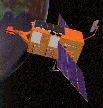Rossi X-Ray Timing Explorer (RXTE): December 1995 - January 2012
The spacecraft was designed and built by the Applied Engineering and Technology Directorate at NASA Goddard Space Flight Center. The launch vehicle was a Delta II rocket that put RXTE into its intended low-earth circular orbit at an altitude of 580 km, corresponding to an orbital period of about 90 minutes, with an inclination of 23 degrees. Operations were managed at Goddard Space Flight Center. The scientific planning and data processing take place at the RXTE Science Operations Center (SOC) comprising the:
InstrumentationThe mission carries two pointed instruments, the Proportional Counter Array (PCA) developed by GSFC to cover the lower part of the energy range, and the High Energy X-ray Timing Experiment (HEXTE) developed by UCSD covering the upper energy range. These instruments are equipped with collimators yielding a FWHM of one degree. In addition, RXTE carries an All-Sky Monitor (ASM) from MIT that scans about 80% of the sky every orbit, allowing monitoring at time scales of 90 minutes or longer. Data from PCA and ASM are processed on board by the Experiment Data System (EDS), also built by MIT.
|


 The Rossi X-ray Timing Explorer (RXTE) was launched on December
30, 1995 from NASA's Kennedy Space Center. The mission was managed
and controlled by NASA's Goddard Space Flight Center (GSFC) in
Greenbelt, Maryland. RXTE features unprecedented time resolution
in combination with moderate spectral resolution to explore the
variability of X-ray sources. Time scales from microseconds to
months are covered in an instantaneous spectral range from 2 to
250 keV. Originally designed for a required lifetime of two years
with a goal of five, RXTE spectacularly passed that goal and completed
16 years of observations before being decommisioned on January 5, 2012.
The Rossi X-ray Timing Explorer (RXTE) was launched on December
30, 1995 from NASA's Kennedy Space Center. The mission was managed
and controlled by NASA's Goddard Space Flight Center (GSFC) in
Greenbelt, Maryland. RXTE features unprecedented time resolution
in combination with moderate spectral resolution to explore the
variability of X-ray sources. Time scales from microseconds to
months are covered in an instantaneous spectral range from 2 to
250 keV. Originally designed for a required lifetime of two years
with a goal of five, RXTE spectacularly passed that goal and completed
16 years of observations before being decommisioned on January 5, 2012.
